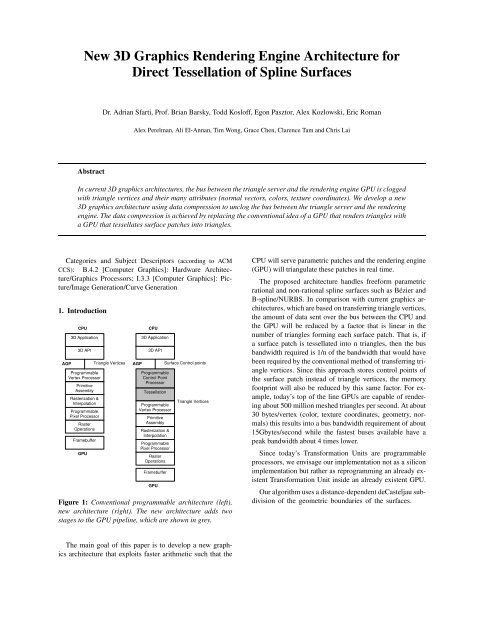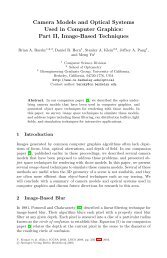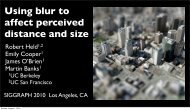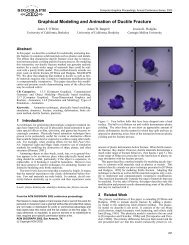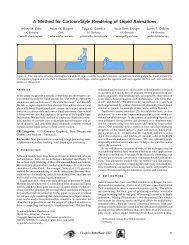Download Paper - Computer Graphics - University of California ...
Download Paper - Computer Graphics - University of California ...
Download Paper - Computer Graphics - University of California ...
You also want an ePaper? Increase the reach of your titles
YUMPU automatically turns print PDFs into web optimized ePapers that Google loves.
New 3D <strong>Graphics</strong> Rendering Engine Architecture for<br />
Direct Tessellation <strong>of</strong> Spline Surfaces<br />
Dr. Adrian Sfarti, Pr<strong>of</strong>. Brian Barsky, Todd Kosl<strong>of</strong>f, Egon Pasztor, Alex Kozlowski, Eric Roman<br />
Alex Perelman, Ali El-Annan, Tim Wong, Grace Chen, Clarence Tam and Chris Lai<br />
Abstract<br />
In current 3D graphics architectures, the bus between the triangle server and the rendering engine GPU is clogged<br />
with triangle vertices and their many attributes (normal vectors, colors, texture coordinates). We develop a new<br />
3D graphics architecture using data compression to unclog the bus between the triangle server and the rendering<br />
engine. The data compression is achieved by replacing the conventional idea <strong>of</strong> a GPU that renders triangles with<br />
a GPU that tessellates surface patches into triangles.<br />
Categories and Subject Descriptors (according to ACM<br />
CCS): B.4.2 [<strong>Computer</strong> <strong>Graphics</strong>]: Hardware Architecture/<strong>Graphics</strong><br />
Processors; I.3.3 [<strong>Computer</strong> <strong>Graphics</strong>]: Picture/Image<br />
Generation/Curve Generation<br />
1. Introduction<br />
AGP<br />
CPU<br />
3D Application<br />
3D API<br />
Programmable<br />
Vertex Processor<br />
Primitive<br />
Assembly<br />
Rasterization &<br />
Interpolation<br />
Programmable<br />
Pixel Processor<br />
Raster<br />
Operations<br />
Framebuffer<br />
GPU<br />
Triangle Vertices<br />
AGP<br />
CPU<br />
3D Application<br />
3D API<br />
Programmable<br />
Control Point<br />
Processor<br />
Tessellation<br />
Programmable<br />
Vertex Processor<br />
Primitive<br />
Assembly<br />
Rasterization &<br />
Interpolation<br />
Programmable<br />
Pixel Processor<br />
Raster<br />
Operations<br />
Framebuffer<br />
GPU<br />
Surface Control points<br />
Triangle Vertices<br />
Figure 1: Conventional programmable architecture (left),<br />
new architecture (right). The new architecture adds two<br />
stages to the GPU pipeline, which are shown in grey.<br />
CPU will serve parametric patches and the rendering engine<br />
(GPU) will triangulate these patches in real time.<br />
The proposed architecture handles freeform parametric<br />
rational and non-rational spline surfaces such as Bézier and<br />
B-spline/NURBS. In comparison with current graphics architectures,<br />
which are based on transferring triangle vertices,<br />
the amount <strong>of</strong> data sent over the bus between the CPU and<br />
the GPU will be reduced by a factor that is linear in the<br />
number <strong>of</strong> triangles forming each surface patch. That is, if<br />
a surface patch is tessellated into n triangles, then the bus<br />
bandwidth required is 1/n <strong>of</strong> the bandwidth that would have<br />
been required by the conventional method <strong>of</strong> transferring triangle<br />
vertices. Since this approach stores control points <strong>of</strong><br />
the surface patch instead <strong>of</strong> triangle vertices, the memory<br />
footprint will also be reduced by this same factor. For example,<br />
today’s top <strong>of</strong> the line GPUs are capable <strong>of</strong> rendering<br />
about 500 million meshed triangles per second. At about<br />
30 bytes/vertex (color, texture coordinates, geometry, normals)<br />
this results into a bus bandwidth requirement <strong>of</strong> about<br />
15Gbytes/second while the fastest buses available have a<br />
peak bandwidth about 4 times lower.<br />
Since today’s Transformation Units are programmable<br />
processors, we envisage our implementation not as a silicon<br />
implementation but rather as reprogramming an already existent<br />
Transformation Unit inside an already existent GPU.<br />
Our algorithm uses a distance-dependent deCasteljau subdivision<br />
<strong>of</strong> the geometric boundaries <strong>of</strong> the surfaces.<br />
The main goal <strong>of</strong> this paper is to develop a new graphics<br />
architecture that exploits faster arithmetic such that the
2 Dr. Adrian Sfarti, Pr<strong>of</strong>. Brian Barsky, Todd Kosl<strong>of</strong>f, Egon Pasztor, Alex Kozlowski, Eric RomanAlex Perelman, Ali El-Annan, Tim Wong, Grace Chen, Clarence Tam and Chr<br />
o<br />
2. Previous Work<br />
There have been very few implementations <strong>of</strong> real time tesselation<br />
in hardware. In the mid-1980’s, Sun developed an<br />
architecture for this that was described in [LSP87] and in<br />
a series <strong>of</strong> associated patents. The implementation was not<br />
a significant technical or commercial success because it did<br />
not exploit triangle based rendering; instead it attempted to<br />
render the surfaces in a pixel-by-pixel manner [LS87]. The<br />
idea was to use adaptive forward differencing to interpolate<br />
infinitesimally close parallel cubic curves imbedded into the<br />
bicubic surface.<br />
More recently, Henry Moreton from NVIDIA has resurrected<br />
the real time tesselation unit [Mor03]. This method<br />
does not directly tesselate patches in real time; rather, it uses<br />
<strong>of</strong>f-line pre-tesselated triangle meshes in conjunction with a<br />
proprietary stitching method that avoids cracking and popping<br />
at the seams. Using this approach, the tessellation unit<br />
exists in front <strong>of</strong> the transformation unit and outputs triangle<br />
databases to be rendered by the existent components <strong>of</strong> the<br />
3D graphics hardware.<br />
The current paper is based on a recent patent [Sfa03] that<br />
is the first to introduce a real time tesselation processor into<br />
a GPU pipeline. To date, there is no GPU built with a real<br />
time tesselator processor but we hope that the current article<br />
will spark the design <strong>of</strong> such a device.<br />
3. GPU Architectures<br />
3.1. Current State <strong>of</strong> the Art<br />
The pseudo code describing the current state <strong>of</strong> the art GPU<br />
architectures is shown below for the bicubic case. Notation:<br />
Let (s i ,t j ) denote a pair <strong>of</strong> parameter values used in patch parameterization,<br />
V i, j a vertex, and N i, j a vertex normal. Also,<br />
we denote texture coordinates by u i, j and v i, j .<br />
Step 1 (<strong>of</strong>f-line) For each bicubic surface, subdivide the S<br />
and T intervals until each resultant four-sided surface is<br />
below a certain predetermined curvature value.<br />
Step 2 For all bicubic surfaces sharing a common boundary,<br />
take the union <strong>of</strong> the subdivisions to prevent cracks along<br />
the common boundary.<br />
Step 3 For each bicubic surface, For each pair (s i ,t j ), Calculate<br />
(u i, j ,v i, j ,q i, j ,V i, j ), Generate triangles by connecting<br />
neighboring vertices.<br />
Step 4 For each vertex V i, j Calculate the normal N i, j to that<br />
vertex (used for lighting). For each triangle Calculate the<br />
normal to the triangle (used for culling).<br />
Step 5 (real time) Transform the vertices V i, j and the normals<br />
N i, j and the normals to the triangles. For each vertex<br />
V i, j , Calculate lighting.<br />
3.2. The Tesselator Unit – Principles <strong>of</strong> Operation<br />
Though we have not implemented our proposed GPU in silicon<br />
yet we are publishing below the behavioral code<br />
describing the principles <strong>of</strong> operation.<br />
o<br />
Step 0 (all steps in real time) ( For each surface transform<br />
only 16 points instead <strong>of</strong> transforming all the vertices inside<br />
the surface. There is no need to transform the normals<br />
to the vertices since they are generated at step 4). For each<br />
bicubic surface Transform the 16 control points and the<br />
single normal that determine the surface.<br />
Step 1 (Simplify the three dimensional surface subdivision<br />
by reducing it to the subdivision <strong>of</strong> the cubic curves determined<br />
by the surface bounding box). For each bicubic<br />
surface, Subdivide the boundary curve representing the s<br />
interval until the projection <strong>of</strong> the length <strong>of</strong> the height <strong>of</strong><br />
the curve bounding box is below a certain predetermined<br />
number <strong>of</strong> pixels as measured in screen coordinates. Subdivide<br />
the boundary curve representing the t interval until<br />
the projection <strong>of</strong> the length <strong>of</strong> the height <strong>of</strong> the curve<br />
bounding box is below a certain predetermined number <strong>of</strong><br />
pixels as measured in screen coordinates.<br />
(Simplify the subdivision termination criterion by expressing<br />
it in screen (SC) coordinates and by measuring<br />
the curvature in pixels. For each new view, a new subdivision<br />
can be generated, producing automatic level <strong>of</strong><br />
detail).<br />
Step 2 For all bicubic surfaces sharing a same parameter<br />
(either s or t) boundary, Choose as the common subdivision<br />
the reunion <strong>of</strong> the subdivisions in order to prevent<br />
cracks showing along the common boundary OR choose<br />
as the common subdivision the finest subdivision (the one<br />
with the most points inside the set) OR insert a zippering<br />
strip to smoothly progress from one patch to its neighbor.<br />
(Prevent cracks at the boundary between surfaces).<br />
Step 3 (Generate the vertices, normals, the texture coordinates<br />
and the displacements used for bump and displacement<br />
mapping for the present subdivision) For each bicubic<br />
surface, For each pair (s i ,t j ) (All calculations employ<br />
some form <strong>of</strong> direct evaluation <strong>of</strong> the variables) Calculate<br />
((u i, j ,v i, j ,q i, j ),(p i, j ,r i, j ),V i, j ) thru evaluation (texture<br />
, displacement map and vertex coordinates as a function<br />
<strong>of</strong> (s i ,t j )) Look up vertex displacement (dx i, j ,dy i, j ,dz i, j ).<br />
Generate triangles by connecting neighboring vertices.<br />
Step 4 For each vertex V i, j Calculate the normal N i, j to that<br />
vertex (Already transformed in WC)<br />
4. The Subdivision Step<br />
We use the Lane-Carpenter subdivision algorithm described<br />
in [LCWB80] but we apply our own termination criterion.<br />
The geometric adaptive subdivision induces a corresponding<br />
parametric subdivision.<br />
The following discussion assumes that the Bézier surface<br />
patch is bicubic, but that approach is valid for arbitrary degree.<br />
The four boundary curves <strong>of</strong> a Bézier patch are themselves<br />
Bézier curves, which we subdivide using the following<br />
formulas. We use the following notation: Let P 1 , P 2 , P 3 ,<br />
and P 4 denote the four control points <strong>of</strong> such a curve. We<br />
denote the four control points <strong>of</strong> the left sub-curve by L 1<br />
through L 4 and the control points <strong>of</strong> the right sub-curve by<br />
R 1 through R 4 . Let H denote the midpoint <strong>of</strong> the line segment<br />
connecting P 2 to P 3 .
Dr. Adrian Sfarti, Pr<strong>of</strong>. Brian Barsky, Todd Kosl<strong>of</strong>f, Egon Pasztor, Alex Kozlowski, Eric RomanAlex Perelman, Ali El-Annan, Tim Wong, Grace Chen, Clarence Tam and Chris<br />
L 3<br />
H<br />
R 2<br />
S = [s 3 ,s 2 ,s,1]<br />
T = [t 3 ,t 2 ,t,1] T<br />
y(s,t) = S × M b × P y × M b × T<br />
z(s,t) = S × M b × P z × M b × T<br />
L 4<br />
= R 1<br />
R 3<br />
L 2<br />
P 1<br />
P 2 P 3<br />
P 4<br />
Figure 2: Curve Subdivision<br />
For constant S, the matrix M = S × M b × P z ×<br />
M b is constant and the calculation <strong>of</strong> the vertices<br />
V (x(s,t),y(s,t),z(s,t)) reduces to the evaluation <strong>of</strong> the vector<br />
T plus the computing <strong>of</strong> the product M × T . Therefore,<br />
the generation <strong>of</strong> vertices is comparable with vertex transformation.<br />
Note that the vertices are generated already transformed<br />
in place because the parent bicubic surface has already<br />
been transformed.<br />
To determine the vertex normals for each generated vertex<br />
V i, j , we calculate the gradient to the surface.<br />
We calculate the texture coordinates through bilinear interpolation.<br />
The parametrization <strong>of</strong> the surface produces a<br />
natural interpolation <strong>of</strong> the texture coordinates (see Figure 3<br />
for details).<br />
L 1 = P 1<br />
L 2 = P 1 + P 2<br />
2<br />
H = P 2 + P 3<br />
2<br />
L 3 = L 2 + H<br />
2<br />
R 4 = P 4<br />
R 3 = P 3 + P 4<br />
2<br />
R 2 = R 3 + H<br />
2<br />
R 1 = L 4 = L 3 + R 2<br />
2<br />
The edge subdivision results in a subdivision <strong>of</strong><br />
the parametric intervals s{s 0 ,s 1 ,...s i ,...s m } and<br />
t{t 0 ,t 1 ,...t j ,...t n }. These parameter values are stored,<br />
whereas the control points resulting from subdivision are<br />
discarded immediately after the termination test is run.<br />
After the subdivision and crack prevention steps, the actual<br />
vertex locations throughout the patch are computed from the<br />
stored parameter values, using the following formulas: Let<br />
x(s,t), y(s,t), and z(s,t) denote the functions that compute<br />
vertex locations from parameter values. Let S and T denote<br />
vectors containing the paramater values raised to powers<br />
one through three. We denote the Bernstein basis (expressed<br />
in matrix form) by M b . The matrices P x , P y and P z contain x,<br />
y, and z coordinates (respectively) <strong>of</strong> the 16 control points.<br />
V i j = V (x(s i ,t j ),y(s i ,t j ),z(s i ,t j ))i = 1,m, j = 1,n<br />
x(s,t) = S × M b × P x × M b × T<br />
P 21<br />
S=0, T=0<br />
P 2 (t)<br />
P 1 (t)<br />
P 32<br />
P 41<br />
P 3 (t)<br />
S=1, T=0 P 4 (t)<br />
P 33<br />
P 34<br />
P 12<br />
S=0, T=1<br />
P 44<br />
S=1, T=1<br />
5. Termination Criteria<br />
(0,1)<br />
Figure 3: Texture Coordinates<br />
V<br />
Texture Space<br />
(0,0) (1,0)<br />
Our algorithm decides that an edge curve has been sufficiently<br />
subdivided when the trapezoidal convex hull <strong>of</strong> that<br />
curve has a sufficiently small height, as seen from the viewpoint<br />
<strong>of</strong> the observer. Referring to Figure 4, subdivision terminates<br />
when the following condition is met:<br />
Maximum{distance(P 12 to line(P 11 ,P 14 )),<br />
2d<br />
distance(P 13 to line(P 11 ,P 14 ))} × (|P 12z |+|P 13z |) < n<br />
AND<br />
Maximum {distance(P 24 to line(P 14 ,P 44 )),<br />
2d<br />
distance(P 34 to line(P 14 ,P 44 ))} × (|P 24z |+|P 34z |) < n<br />
where n is an arbitrary number expressed in pixels or in a<br />
fraction <strong>of</strong> pixels and d is the distance from the viewer to the<br />
projection plane.<br />
We experimented with n starting at 1 and we observed that<br />
there were artifacts, especially along the silhouette. Forsey<br />
et al. [FK90] seem to settle on n = .5 and we tried that. We<br />
(1,1)<br />
U
4 Dr. Adrian Sfarti, Pr<strong>of</strong>. Brian Barsky, Todd Kosl<strong>of</strong>f, Egon Pasztor, Alex Kozlowski, Eric RomanAlex Perelman, Ali El-Annan, Tim Wong, Grace Chen, Clarence Tam and Chr<br />
also experimented with n > 1, for reasons <strong>of</strong> rapid prototyping<br />
and previewing. The above criterion is sufficient for<br />
surface patches that are not more curved inside their boundaries<br />
than they are along their boundaries. The criterion ensures<br />
that abutting patches share the same subdivision along<br />
the common boundary. Conversely, if the patches are more<br />
curved inside than they are along their boundaries, we add a<br />
criterion that has a slightly modified form:<br />
Y<br />
Z<br />
P 21<br />
P 2 (t)<br />
P 1 (t)<br />
P 32<br />
P 3 (t)<br />
P 4 (t)<br />
P 33<br />
P 34<br />
P 12<br />
P 41 P 42<br />
P 43<br />
P 44<br />
Maximum {distance(P 22 to line(P 42 ,P 12 )),<br />
2d<br />
distance(P 32 to line(P 42 ,P 12 ))} × (|P 42z |+|P 12z | < n<br />
AND<br />
Maximum {distance(P 32 to line(P 31 ,P 34 )),<br />
2d<br />
distance(P 33 to line(P 31 ,P 34 ))} × (|P 31z |+|P 34z |) < n<br />
Since the curvature <strong>of</strong> free-form surfaces can switch between<br />
being boundary-limited and internally-limited, we<br />
will need to measure the flatness <strong>of</strong> both types <strong>of</strong> curves at<br />
the start <strong>of</strong> the tesselation associated with each instance <strong>of</strong><br />
the surface by subdividing the four boundary curves as well<br />
as two orthogonal internal curves, specifically the curves that<br />
interverne in the second termination criterion shown above.<br />
We can further exploit the fact that adjacent patches share<br />
two boundary curves so that we need to subdivide only two<br />
<strong>of</strong> the four boundary curves for each patch. The only obvious<br />
exceptions are the patches at the boundary <strong>of</strong> a surface, since<br />
such patches have fewer than four neighbors. In the case <strong>of</strong><br />
the boundary patches, our algorithm always subdivides all<br />
four boundary curves. As long as abutting patches share the<br />
same boundary curves, this approach guarantees edge continuity<br />
between surfaces without the need to share any edge<br />
information between patches.<br />
Our termination test ensures that patches are subdivided<br />
sufficiently to avoid silhouette artifacts. However, the test<br />
was shown to be insufficient in the case <strong>of</strong> a large flat patch<br />
facing the viewer. Such a patch would not be subdivided because<br />
a single pair <strong>of</strong> triangles can completely capture the<br />
geometry <strong>of</strong> this curve. However, per-vertex lighting would<br />
lead to highlight artifacts. Additionally, nearly-flat portions<br />
<strong>of</strong> a patch exhibit undesirable texture flickering as they visibly<br />
transition from one level <strong>of</strong> detail to the next. This is<br />
because the bilinear texture coordinate interpolation that we<br />
use when assigning texture coordinates to triangle vertices is<br />
not the same as the method used to interpolate within a triangle.<br />
To combat this problem, we decree that patches must be<br />
subdivided a minimum number <strong>of</strong> times, regardless <strong>of</strong> curvature.<br />
6. Crack Prevention<br />
If there are no special prevention methods, cracks may<br />
appear at the boundary between abutting patches. This is<br />
mainly due to the fact that the patches are subdivided independently<br />
<strong>of</strong> each other. Abutting patches can exhibit different<br />
curvatures resulting in different subdivisions. For example,<br />
in Figure 7, we see that the right-hand patch has a<br />
finer subdivision than the left-hand one. At the boundary, we<br />
see how a “T-joint” has been formed. When rendering the<br />
parallel strips <strong>of</strong> triangles to the left and to the right <strong>of</strong> the<br />
d<br />
X<br />
Figure 4: Termination Criteria<br />
Figure 5: Without Crack Prevention (note cracks appearing<br />
around the handle in the middle <strong>of</strong> the lid <strong>of</strong> the teapot, and<br />
at the tip <strong>of</strong> the spout).<br />
common boundary, a crack may become visible in the area<br />
<strong>of</strong> the T-joint.<br />
If two patches bounding two separate surfaces share an<br />
edge curve, they share the same control points and they will<br />
share the same tesselation. By doing so we ensure the absence<br />
<strong>of</strong> cracks between patches that belong to data structures<br />
that have been dispatched independently and thus our<br />
method scales the exact same way the traditional triangle<br />
based method does.<br />
Zippering leaves the interior <strong>of</strong> patches untouched, allowing<br />
these regions to be tessellated without concern for<br />
neighboring patches. To eliminate cracks between adjacent<br />
patches (as in Figure 5), the portion <strong>of</strong> a patch that is immediately<br />
in contact with an adjacent patch is carefully tessellated<br />
using a zipper-like configuration, so as to seamlessly<br />
move from a lower to higher level <strong>of</strong> tesselation. An example<br />
<strong>of</strong> zippering is shown in Figure 8.<br />
We tested the crack prevention algorithm on a large selection<br />
<strong>of</strong> objects, making sure that the method works on corner<br />
cases such as the fans <strong>of</strong> patches shown in figure 8.<br />
7. Performance Measurements<br />
In order to measure the performance <strong>of</strong> the algorithm, we<br />
tested our prototype on five dynamic scenes. Each scene
Dr. Adrian Sfarti, Pr<strong>of</strong>. Brian Barsky, Todd Kosl<strong>of</strong>f, Egon Pasztor, Alex Kozlowski, Eric RomanAlex Perelman, Ali El-Annan, Tim Wong, Grace Chen, Clarence Tam and Chris<br />
Figure 6: With Crack Prevention<br />
Figure 8: Zippering In Action<br />
the main performance savings in our architecture will come<br />
from the AGP/PCIX bus bandwidth reduction we wanted to<br />
verify that our approach does not create a bottleneck inside<br />
the GPU. We obtained ample pro<strong>of</strong> that this is not the case<br />
by trying many scenarios that allow for complex animations<br />
<strong>of</strong> flocks <strong>of</strong> objects in the context <strong>of</strong> a variable viewpoint .<br />
We have made several movies <strong>of</strong> our animations as well as a<br />
menu driven interactive demo.<br />
T-Join<br />
Figure 7: Cracking<br />
comprised seven teapots that were spun along different elliptical<br />
paths. At any given moment, some teapots are close<br />
to the viewer, while others are far away. We recorded the average<br />
time it took to tessellate each scene (in milliseconds)<br />
as well as the average frames rate. Our back-patch culling<br />
feature was turned on.<br />
All tests were performed on a Pentium 4 2.4Ghz machine<br />
with a GeForce4 MX440 video card. We realize that the performance<br />
testing is done on a s<strong>of</strong>tware simulation <strong>of</strong> the Tesselator<br />
Unit architecture since none <strong>of</strong> the existent GPU’s<br />
has one today. Therefore, the performance numbers are only<br />
indicative <strong>of</strong> the performance <strong>of</strong> the actual architecture. Nevertheless,<br />
it was immediately observed that the dynamic tessellation<br />
compares favorably with the fixed tesselation since<br />
it shows higher frame rates in most cases, as described below.<br />
The quality <strong>of</strong> the rendering is improved as well , especially<br />
for the cases when the objects are very close to<br />
the viewer. We observed no disadvantages to our method<br />
as compared to the conventional method. We experimented<br />
with a scene that had a fixed tesselation <strong>of</strong> 64k triangles. By<br />
using the real time tesselation the number <strong>of</strong> triangles varied<br />
from a maximum <strong>of</strong> 16k (closest from the viewer) down<br />
to a few hundreds (farthest from the viewer) clearly demonstrating<br />
the compression capabilities <strong>of</strong> our method. Since<br />
Figure 9 shows an average <strong>of</strong> the values obtained during<br />
the testing <strong>of</strong> all five scenes, all results in expressed in<br />
“frames per second” (fps).<br />
The “RTT” entry represents our real time tesselation<br />
method. We separated the measurements into transform+tesselate<br />
only vs. transform+tesselate+render. The<br />
reason is that we wanted to measure the exact effects <strong>of</strong> the<br />
tesselation by comparison with conventional <strong>of</strong>fline tesselation.<br />
In a real GPU there would be a tesselator unit stage,<br />
so that the effects <strong>of</strong> tesselation on execution time would be<br />
hidden by the fact that the GPU is pipelined. We rendered<br />
the same animation four different times, each time at a different<br />
criterion <strong>of</strong> subdivision termination (n = 0.5, n = 0.7,<br />
n = 1, n = 2). As n (the fractional deviation <strong>of</strong> the planar<br />
approximation from the real surface, expressed in pixels) increases,<br />
the number <strong>of</strong> triangles generated from subdivision<br />
decreases and the speed increases.<br />
We also implemented a feature to simulate the current<br />
standard rendering methods whereby models are tessellated<br />
<strong>of</strong>fline and then sent to the GPU as sets <strong>of</strong> triangles. This<br />
is the “Offline Tesselation” entry at the bottom <strong>of</strong> the table.<br />
Each patch is tessellated uniformly to a user-defined number<br />
<strong>of</strong> triangles (128, 512, or 2048). On every frame, each<br />
pre-calculated vertex is transformed from model space into<br />
world coordinates. The normal <strong>of</strong> each vertex is also appropriately<br />
transformed into world coordinates. Then the triangle<br />
is rendered directly.<br />
In all scenes, because the number <strong>of</strong> triangles remains<br />
constant between frames and no dynamic tessellation occurs,<br />
there was negligible deviation between values obtained<br />
while rendering different scenes. Figure 9 shows the timings<br />
obtained on all scenes tested.
6 Dr. Adrian Sfarti, Pr<strong>of</strong>. Brian Barsky, Todd Kosl<strong>of</strong>f, Egon Pasztor, Alex Kozlowski, Eric RomanAlex Perelman, Ali El-Annan, Tim Wong, Grace Chen, Clarence Tam and Chr<br />
Triangles<br />
Generated<br />
RTT<br />
Transform + Tessellate Transform + Tessellate +<br />
Render<br />
N<br />
milliseconds fps milliseconds fps<br />
0.5 29~34K 21.7 43.1 23.6 40.1<br />
0.7 24~28K 19.9 47.0 21.5 43.8<br />
1.0 24~26K 19.3 48.3 20.9 45.0<br />
2.0 24~26K 19.2 48.7 20.8 45.3<br />
Offline Tessellation<br />
Triangles<br />
Per Patch<br />
Triangles<br />
Generated<br />
Overall<br />
Transform<br />
Transform + Render<br />
milliseconds fps milliseconds fps<br />
128 28K 6.3 60+ 15.2 60+<br />
512 115K 18.3 51.3 30.1 32.0<br />
2048 459K 66.7 14.5 81.9 11.9<br />
Figure 9: Performance Measurements: Averages<br />
8. A Prototype for a <strong>Graphics</strong> Utility Library<br />
To facilitate the design <strong>of</strong> drivers for the proposed architecture,<br />
we must develop a <strong>Graphics</strong> Utility Library (GLU).<br />
The primitives <strong>of</strong> the GLU are strips, fans, meshes and indexed<br />
meshes. Current rendering methods are based on triangle<br />
databases (strips, fans, meshes) that result from <strong>of</strong>fline<br />
tesselation via specialized tools. These tools tesssellate the<br />
patch databases and ensure that there are no cracks between<br />
the resulting triangle databases. The tools use some form <strong>of</strong><br />
zippering. The triangle databases are then streamed over the<br />
AGP bus into the GPU. There is no need for any coherency<br />
between the strips, fans, etc., since they are, by definition,<br />
coherent (there are no T-joints between them). The net result<br />
is that the GPU does not need any information about the entire<br />
database <strong>of</strong> triangles, which can be quite huge. Thus, the<br />
GPUs can process virtually infinite triangle databases.<br />
Consider again the bicubic case. Below, we illustrate the<br />
first three primitives. Referring to Figure 11, in a strip, the<br />
first patch will contribute sixteen vertices, and each successive<br />
patch will contribute only twelve vertices because<br />
four vertices are shared with the previous patch. Of the 16<br />
vertices <strong>of</strong> the first patch, S 1 , there will be only four vertices<br />
(namely, the corners P 11 , P 14 , P 41 , P 44 ) that will have<br />
color and texture attributes; the remaining twelve vertices<br />
will have only geometry attributes. Of the twelve vertices<br />
<strong>of</strong> each successive patch, S i , in the strip, there will only be<br />
one vertex, (namely P 44 ) that will have color and texture attributes.<br />
It is this reduction in the number <strong>of</strong> vertices that will<br />
have color and texture attributes that accounts for the reduction<br />
<strong>of</strong> the memory footprint and reduction <strong>of</strong> the reduction<br />
<strong>of</strong> the bus bandwidth necessary for transmitting the primitive<br />
from the CPU to the rendering engine (GPU) over the<br />
AGP bus. Further compression is achieved because a patch<br />
will be expanded into potentially many triangles by the Tesselator<br />
Unit inside the GPU.<br />
Each patch has an outward pointing normal. Referring to<br />
Figure 12, each patch has only three boundary curves, the<br />
fourth boundary having collapsed to the center <strong>of</strong> the fan.<br />
The first patch in the fan enumeration has eleven vertices;<br />
each subsequent patch has eight vertices. The vertex P 11 ,<br />
which is listed first in the fan definition, is the center <strong>of</strong> the<br />
fan and has color and texture attributes in addition to geometric<br />
attributes. The first patch, S 1 , has two vertices with<br />
color and texture attributes, namely P 41 and P 14 ; the remaining<br />
nine vertices have only geometric attributes. Each successive<br />
patch, S i , has only one vertex with all the attributes.<br />
Referring to Figure 10, in a mesh, the anchor patch, S 11 has<br />
sixteen vertices, all the patches in the horizontal and vertical<br />
strips attached to S 11 have twelve vertices and all the other<br />
patches have nine vertices.<br />
S M1<br />
12 Control<br />
Points<br />
S 21<br />
12 Control<br />
Points<br />
S 11<br />
16 Control<br />
Points<br />
Mesh (S 11<br />
, S 12<br />
, ... S 1N<br />
, ... S 21<br />
, ... S 2N<br />
, ... S M1<br />
, ... S MN<br />
)<br />
S M2<br />
9<br />
S 22<br />
9 Control<br />
Points<br />
S 12<br />
12 Control<br />
Points<br />
4<br />
Figure 10: Mesh<br />
The meshed curved patch data structures introduced<br />
above are designed to replace the triangle data structures<br />
used in the conventional architectures.<br />
S Mi<br />
9<br />
S 2i<br />
9<br />
S 1i<br />
12<br />
S MN<br />
9<br />
S 2N<br />
9<br />
S 1N<br />
12
Dr. Adrian Sfarti, Pr<strong>of</strong>. Brian Barsky, Todd Kosl<strong>of</strong>f, Egon Pasztor, Alex Kozlowski, Eric RomanAlex Perelman, Ali El-Annan, Tim Wong, Grace Chen, Clarence Tam and Chris<br />
Strip (S 1<br />
, S 2<br />
, ... S i<br />
, ... S n<br />
)<br />
P 11 P<br />
P 14<br />
12<br />
P 13<br />
P 21<br />
P 23<br />
P 24<br />
P 22<br />
P 33<br />
P 31<br />
P 32<br />
P 34<br />
P 41<br />
P 42<br />
P 43<br />
P 44<br />
S 1<br />
S 2<br />
S i<br />
16 Control points<br />
12 Control points<br />
12 Control points<br />
P 11<br />
, P 14<br />
, P 41<br />
, P 44<br />
(Color, texture, geometry)<br />
S 1 P 12<br />
... P 43<br />
(Geometry)<br />
N =<br />
outwards pointing normal<br />
P 11<br />
, P 14<br />
, P 41<br />
, P 44<br />
S i<br />
{P 12<br />
... P 43<br />
} - {P 21<br />
, P 31<br />
}<br />
N<br />
Figure 11: Strip<br />
P 11<br />
P 21<br />
P 22<br />
P 31<br />
P 12<br />
P 32<br />
P 23<br />
=P 33<br />
P 13<br />
=P 34<br />
P 43<br />
=P 24<br />
P<br />
P 42<br />
41<br />
S 1<br />
S i<br />
P 14<br />
=P 44<br />
11 Control Points<br />
8 Control Points<br />
P 11<br />
, P 14<br />
, P 41<br />
, P 44<br />
(Color, texture, geometry)<br />
S 1<br />
S i<br />
{ P 12<br />
... P 43<br />
} - {P 24<br />
,P 34<br />
, P 33<br />
} (Geometry)<br />
N<br />
P 11<br />
, P 14<br />
, P 41<br />
, P 44<br />
{P 12<br />
... P 43<br />
} - {P 24<br />
,P 34<br />
, P 33<br />
} - {P 12<br />
, P 13<br />
}<br />
N<br />
Figure 12: Fan
8 Dr. Adrian Sfarti, Pr<strong>of</strong>. Brian Barsky, Todd Kosl<strong>of</strong>f, Egon Pasztor, Alex Kozlowski, Eric RomanAlex Perelman, Ali El-Annan, Tim Wong, Grace Chen, Clarence Tam and Chr<br />
No information needs to be stored between two abutting<br />
patches. If two patches bounding two separate surfaces<br />
share an edge curve, they share the same control points and<br />
they will share the same tesselation. By doing so we ensure<br />
the absence <strong>of</strong> cracks between patches that belong to data<br />
structures that have been dispatched independently and thus<br />
our method scales the exactly the same way the traditional<br />
triangle based method does.<br />
9. Conclusion<br />
We developed a new 3D graphics architecture using data<br />
compression to unclog the bus between the triangle server<br />
and the rendering engine. The data compression is achieved<br />
by replacing the conventional idea <strong>of</strong> a rendering engine that<br />
renders triangles with a rendering engine that will tessellate<br />
surface patches into triangles. Thus, the bus sends control<br />
points <strong>of</strong> the surface patches, instead <strong>of</strong> the many triangle<br />
vertices forming the surface, to the rendering engine. The<br />
tessellation <strong>of</strong> the surface patches into triangles is distancedependent,<br />
it needs to be done in real time inside the rendering<br />
engine.<br />
References<br />
[BAD ∗ 01]<br />
[BDD87]<br />
BOO M., AMOR M., DOGGET M., HIRCHE J.,<br />
STRASSER W.: Hardware support for adaptive<br />
subdivision surface rendering. In Proceedings<br />
<strong>of</strong> the ACM SIGGRAPH/Eurographics workshop<br />
on <strong>Graphics</strong> Hardware (2001), pp. 33–40.<br />
BARSKY B. A., DEROSE T. D., DIPPE M. D.:<br />
An adaptive subdivision method with crack<br />
prevention for rendering beta-spline objects.<br />
Technical Report, UCB/CSD 87/384, <strong>Computer</strong><br />
Science Division, Electrical Engineering and<br />
<strong>Computer</strong> Sciences Department, <strong>University</strong> <strong>of</strong><br />
<strong>California</strong>, Berkeley, <strong>California</strong>, USA (1987).<br />
[CF00] CHUNG A. J., FIELD A.: A simple recursive<br />
tesselator for adaptive surface triangulation.<br />
JGT 5(3) (2000).<br />
[Cla79] CLARK J. H.: A fast algorithm for rendering<br />
parametric surfaces. In <strong>Computer</strong> <strong>Graphics</strong><br />
(SIGGRAPH ’79 Proceedings) (August 1979),<br />
vol. 13(2) Special Issue, ACM, pp. 7–12.<br />
[FK90] FORSEY D. R., KLASSEN R. V.: An adaptive<br />
subdivision algorithm for crack prevention<br />
in the display <strong>of</strong> parametric surfaces. In Proceedings<br />
<strong>of</strong> <strong>Graphics</strong> Interface (1990), pp. 1–8.<br />
[Hop97]<br />
[KBK02]<br />
HOPPE H.: View-dependent refinement <strong>of</strong> progressive<br />
meshes. In Proceedings <strong>of</strong> the 24th annual<br />
conference on computer graphics and interactive<br />
techniques (1997).<br />
KAHLESZ F., BALAZS A., KLEIN R.: Nurbs<br />
rendering in opensg plus. In OpenSG 2002 <strong>Paper</strong>s<br />
(2002).<br />
displaying parametrically defined surfaces. In<br />
Communications <strong>of</strong> the ACM (January 1980),<br />
vol. 23(1), ACM, pp. 23–24.<br />
[LS87] LIEN S.-L., SHANTZ M.: Shading bicubic<br />
patches. In SIGGRAPH ’87 Proceedings<br />
(1987), ACM, pp. 189–196.<br />
[LSP87]<br />
[MM02]<br />
LIEN S.-L., SHANTZ M., PRATT V. R.: Adaptive<br />
forward differencing for rendering curves<br />
and surfaces. In SIGGRAPH ’87 Proceedings<br />
(1987), ACM, pp. 111–118.<br />
MOULE K., MCCOOL M.: Efficient bounded<br />
adaptive tesselation <strong>of</strong> displacement maps. In<br />
<strong>Graphics</strong> Interface 2002 (2002).<br />
[Mor01] MORETON H. P.: Watertight tesellation using<br />
forward differencing. In Proceedings <strong>of</strong><br />
the ACM SIGGRAPH/Eurographcs workshop<br />
on graphics hardware (2001).<br />
[Mor03] MORETON H. P.: Integrated tesselator in a<br />
graphics processing unit. U.S. patent (July 22<br />
2003). #6,597,356.<br />
[Sfa01]<br />
SFARTI A.: System and method for adjusting<br />
pixel parameters by subpixel positioning. U.S.<br />
patent (2001). #6,219,070.<br />
[Sfa03] SFARTI A.: Bicubic surface rendering. U.S.<br />
patent (2003). #6,563,501.<br />
[VdFG99]<br />
VELHO L., DE FIGUEIREDO L. H., GOMES<br />
J.: A unified approach for hierarchical adaptive<br />
tesselation <strong>of</strong> surfaces. In ACM Transactions<br />
on <strong>Graphics</strong> (1999), vol. 18(4), ACM, pp. 329–<br />
360.<br />
[LCWB80] LANE J. F., CARPENTER L. C., WHITTED<br />
J. T., BLINN J. F.: Scan line methods for


